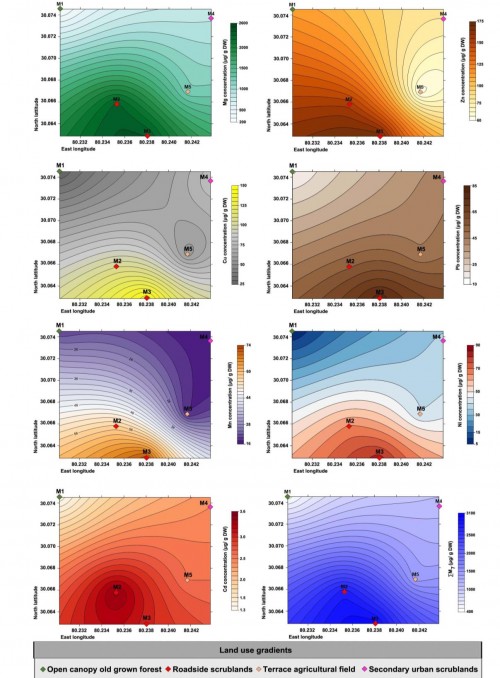Tropical Plant Research
An International Journal by Society for Tropical Plant Research
2019, VOLUME 6 ISSUE 2Pages: 199-205
Lichenized fungi Stereocaulon foliolosum Nyl. (Stereocaulaceae, Ascomycota), indicator of ambient air metal deposition in a temperate habitat of Kumaun, central Himalaya, India
Pramod Nag, Rajan K. Gupta* and Dalip Kumar Upreti
*Department of Botany, Pt. L.M.S. Government Post Graduate College, Rishikesh (Dehradun)-249201, Uttarakhand, India
Abstract:
Himalayan habitats in the past three decades have undergone a tremendous change in the land use pattern. The increase in urbanization and associated vehicular movement had increased the heavy metal influx in the ambient air of Himalayan ecosystems. Bioindicators such as lichens due to their slow growth, longer lifespan and maximum absorption of nutrients through atmospheric deposition, can be used as an appropriate indicator of long-term heavy metal deposition in the Himalaya. In the current study, a terricolous lichen Stereocaulon foliolosum was studied in the temperate habitat of Munsyari, Pithoragarh district, Uttarakhand, central Himalaya, for its ability as a bioindicator of ambient air heavy metal deposition along with land use linked vehicular exhaust gradient. In the current study, Stereocaulon foliolosum was analyzed for lichen diversity and seven heavy metals- (Mg, Zn, Cu, Pb, Mn, Ni, Cd) deposition in five plots in Khaliya bugyal-Munsyari landscape along gradients of land use and elevation. The maximum heavy metal deposition was recorded in plots along roads which minimized in Khaliya bugyal. The total heavy metal load (ΣM7) was found indicative of land use gradient followed by Mg, Zn, Cu and Ni accumulation in lichen thallus. The study concluded that the diversity of Stereocaulon foliolosum was negatively correlated to the vehicular density which was maximum at moderate elevations exhibiting intense land use and maximum vehicular movement. The study thus established that change in lichen diversity can be an appropriate indicator of land use linked pollution gradients in temperate habitat in Kumaun, central Himalaya.
Himalayan habitats in the past three decades have undergone a tremendous change in the land use pattern. The increase in urbanization and associated vehicular movement had increased the heavy metal influx in the ambient air of Himalayan ecosystems. Bioindicators such as lichens due to their slow growth, longer lifespan and maximum absorption of nutrients through atmospheric deposition, can be used as an appropriate indicator of long-term heavy metal deposition in the Himalaya. In the current study, a terricolous lichen Stereocaulon foliolosum was studied in the temperate habitat of Munsyari, Pithoragarh district, Uttarakhand, central Himalaya, for its ability as a bioindicator of ambient air heavy metal deposition along with land use linked vehicular exhaust gradient. In the current study, Stereocaulon foliolosum was analyzed for lichen diversity and seven heavy metals- (Mg, Zn, Cu, Pb, Mn, Ni, Cd) deposition in five plots in Khaliya bugyal-Munsyari landscape along gradients of land use and elevation. The maximum heavy metal deposition was recorded in plots along roads which minimized in Khaliya bugyal. The total heavy metal load (ΣM7) was found indicative of land use gradient followed by Mg, Zn, Cu and Ni accumulation in lichen thallus. The study concluded that the diversity of Stereocaulon foliolosum was negatively correlated to the vehicular density which was maximum at moderate elevations exhibiting intense land use and maximum vehicular movement. The study thus established that change in lichen diversity can be an appropriate indicator of land use linked pollution gradients in temperate habitat in Kumaun, central Himalaya.

Fig.: Concentration of heavy metals analyzed (Mg, Zn, Cu, Pb, Mn, Ni, Cd and total metal load (Æ©M7) in Stereocaulon foliolosum Nyl. from different plots along four land use gradient.
| 0 | 1 | 2 | 5 | 5 | 6 | 4 | 3 |


